Physics and Instrumentation
1/158
There's no tags or description
Looks like no tags are added yet.
Name | Mastery | Learn | Test | Matching | Spaced |
|---|
No study sessions yet.
159 Terms
Pulse-Echo Technique
Pulses are sent into tissues and bounce back creating echoes that provide anatomic information.
What does the strength of an echo correspond to?
The brightness of the dot on the display screen.
What does the brightness of a dot correspond to?
The strength of the echo.
What does the echo return time correspond to?
The location of the reflecting tissue.
What does the location of the dot correspond to?
Echo Return time
Ultrasound machines measure…
Time
Ultrasound machines calculate…
Distance
Displacement Concept
Distance = Speed x Time
Distance = Speed x Time
Displacement Concept
Distance ____ when time Increases
increases
Distance ____ when time decreases
decreases
Average speed of sound used in diagnostic ultrasound
1540 m/s or 1.54 mm/μs
The denser the medium the ____ the speed
faster
Speed of sound equation
C = √(B/P)
where C is the speed of sound, B is the bulk modulus, and P is the density of the medium.
Operating Principle 1
One-to-one correspondence where echoes from one pulse appear as one scan line
Operating Principle 2
Retrospective computational beamforming determines echo information
Two-Dimensional scan formats
Cross sectional images called B scans or gray-scale scans
Linear Format
Closely spaced parallel vertical scan lines which all travel in the same direction with each pulse having a different starting point.
Rectangular Display
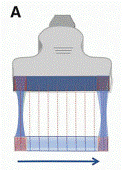
Format?
Linear Format
Sector Format
Each pulse has the same starting point and each pulse travels in slightly different directions.
Pie/Fan Display
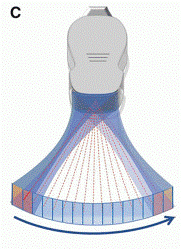
Format?
Sector Format
Combination / Curvilinear Format
Each pulse has slightly different starting points and each pulse travels in slightly different directions.
Curved Display

Format?
Combination / Curvilinear
Volume Imaging
Three-dimensional echo data acquired by many two-dimensional sections placed together.
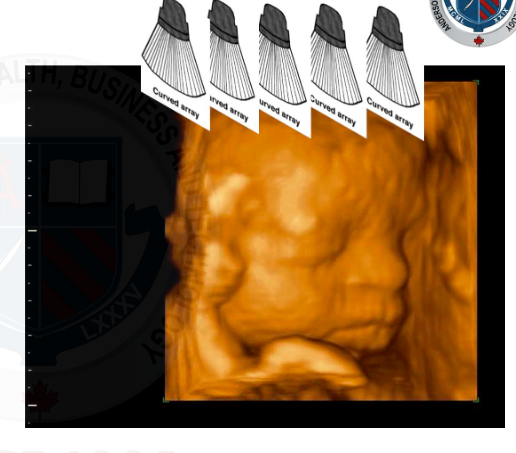
Type of imaging
Volume Imaging / 3D
Doppler Effect
Change in frequency caused by a moving object
Used to detect and measure tissue motion and blood flow
Can be audible, colour or spectral
Colour Doppler
colour-coded representations of information placed on a gray scale image.

Type of doppler
Colour doppler
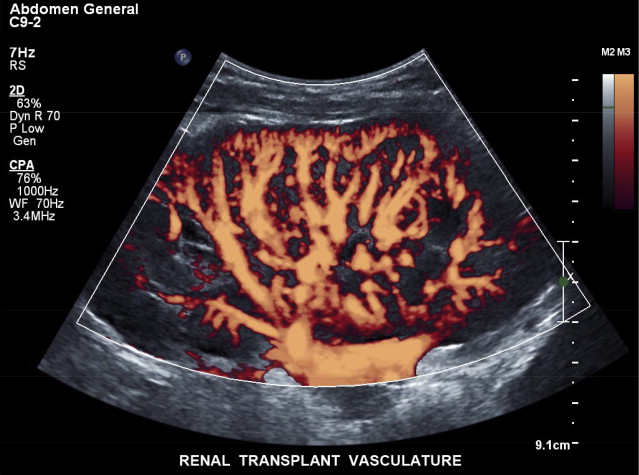
Type of doppler
Power doppler
Spectral Doppler
Information is applied to a speaker for audible evaluation and to a display for analysis.
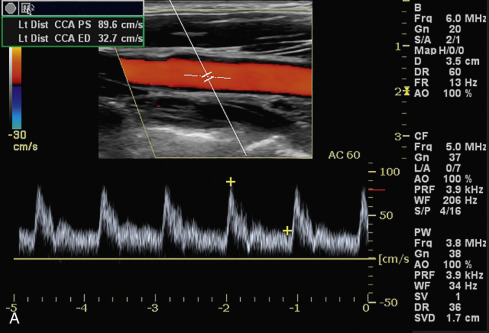
Type of doppler
Spectral doppler
What is sound?
Traveling variation of acoustic variables.
Compressions
High localized pressure
High localized pressure
Compressions
Rarefactions
Low localized pressure
Low localized pressure
Rarefactions
Wavelength (λ)
Is a measure of distance between compressions (a peak and a peak) or rarefactions (a through and a through)
Is a measure of distance between compressions (a peak and a peak) or rarefactions (a through and a through)
Wavelength (λ)
Frequency (F)
How many cycles of a wave pass a particular point in a given period of time.
Units: Hz, kHz, MHz
How many cycles of a wave pass a particular point in a given period of time.
Units: Hz, kHz, MHz
Frequency (F)
Propagation Speed (C)
Determined by the medium it is traveling through
1540 m/s or 1.54 mm/μs
Determined by the medium it is traveling through
1540 m/s or 1.54 mm/μs
Propagation speed (C)
Period (T)
Time it takes for one cycle to occur
Equations for F, C and λ
C = Fλ
F = C/λ
λ = C/F
Equations for T and F
T = 1/F
F = 1/T
When frequency increases the period…
Decreases
When frequency decreases the period…
Increases
When frequency increases the wavelength…
Decreases
When frequency decreases the wavelength…
Increases
Harmonics
High pressure portions of the wave travel faster than low pressure portions.
Results in higher and better resolution.
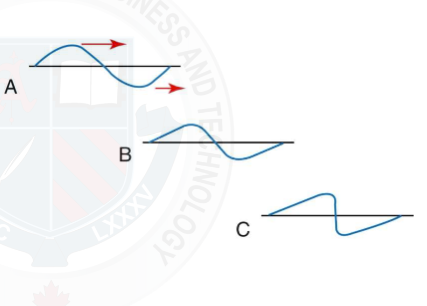
Name
Harmonics
Continuous Wave
A wave that is on 100% of the time.
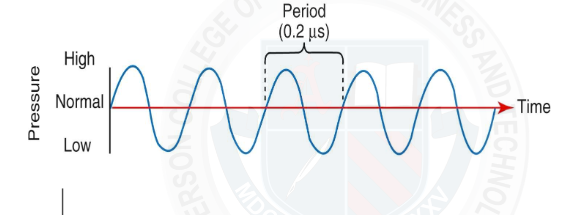
Type of wave
Continuous
Pulsed Wave
A type of wave that is only on for a portion of the time, alternating between wave and listening time
Most commonly used in diagnostic u/s

Type of wave
Pulsed wave

Terms for …
Continuous wave

Terms for …
Pulsed Wave
If frequency increases, period ___ and pulse duration ___
decreases, decreases
If frequency decreases, period ___ and pulse duration ___
increases, increases
If the number of cycles in a pulse decreases, pulse duration ___
decreases.
If the number of cycles in a pulse increases, pulse duration ___
increases.
Shorter pulses = ___ image quality
better
Longer pulses = ___ image quality
worse
if pulse duration increases, duty factor ___
increases
If pulse duration decreases, duty factor ___
decreases
If PRP decreases, duty factor ___
increases
If PRP increases, duty factor ___
decreases
If PRF increases, duty factor
increases
If PRF decreases, duty factor ___
decreases
The shorter the pulse, the ___ the bandwidth
greater
The longer the pulse, the ___ the bandwidth
smaller
If frequency increases, attenuation ___
increases
If frequency decreases, attenuation ___
decreases
Pulse Repetition Frequency (PRF)
The number of pulses occurring in one second
The number of pulses occurring in one second
Pulse Repetition Frequency (PRF)
Pulse Repetition Period (PRP)
The time from the beginning of one pulse to the beginning of the next
The time from the beginning of one pulse to the beginning of the next
Pulse Repetition Period (PRP)

Pulse Repetition ___
Frequency

Pulse Repetition ___
Period
PRF equation
PRF = 1 / PRP
PRP equation
PRP = 1 / PRF
Pulse Duration (PD)
The time for a pulse to occur
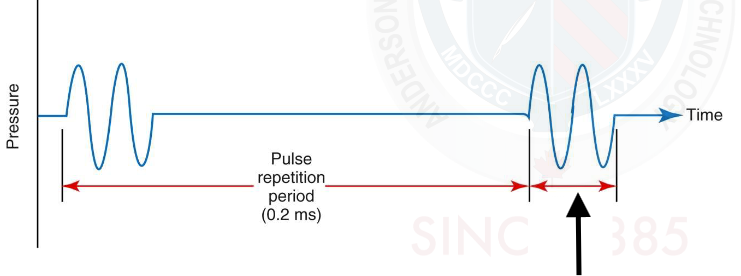
Arrow
Pulse Duration
Pulse Duration Equation
PD = T x # cycles
T = PD / # cycles
# cycles = PD / T
Sonographic pulses are typically ___ cycles long
Doppler pulses are typically ___ cycles long
2-3 , 5-30
Duty Factor (DF)
Fraction of time that pulsed ultrasound is on
DF for 2D u/s is ___% - ___%
DF for doppler u/s is ___% - ___%
DF for continuous wave is ___%
0.1% - 1%
0.5% - 5%
100%
Duty Factor equation
DF = PD / PRP
PD = DF x PRP
PRP = PD / DF
Spatial Pulse Length (SPL)
The length of space that a pulse takes up
The length of space that a pulse takes up
Spatial Pulse Length (SPL)

Arrow
Spatial Pulse Length
Spatial Pulse Length equation
SPL = λ x # cycles
λ = SPL / # cycles
# cycles = SPL / λ
Bandwidth
The range of frequencies contained in a pulse
The range of frequencies contained in a pulse
Bandwidth
Fractional Bandwidth
How large the bandwidth is compared with operating frequency
How large the bandwidth is compared with operating frequency
Fractional Bandwidth

Arrow
Fractional Bandwidth
Fractional Bandwidth equation
Fractional bandwidth = bandwidth / operating frequency
Operating frequency = bandwidth / fractional bandwidth
Bandwidth = fractional bandwidth x operating frequency
Amplitude
The maximum variation that occurs in an acoustic variable
The maximum variation that occurs in an acoustic variable
Amplitude